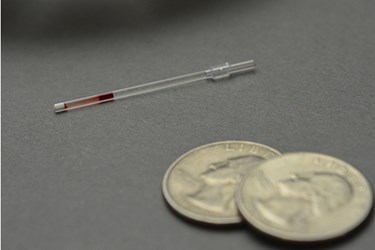Rapid And Cheap Sickle Cell Diagnosis For The Developing World
By Chuck Seegert, Ph.D.

Sickle cell anemia is a major problem in developing African countries, affecting many hundreds of thousands of children each year. Diagnosis is costly and many die because of this, but new research from Harvard could have an impact by providing a cheap and rapid diagnostic test.
Sickle cell anemia is a disease that is common in areas of Africa where malaria is present. In some scenarios, the disease helps people from developing severe malaria, but there are many problems when a person inherits the full form of the disease.
Sickle cells are red blood cells that assume a sickle shape and are much more rigid than normal blood cells. This can cause them to break or rupture when they are forced through narrow capillaries. It can even lead to a buildup in junctions of capillaries, consequently closing them off.
“The best way to state it is in terms of the actual problem,” A. J. Kumar, a postdoctoral fellow who worked with colleagues in the lab of professor George Whitesides to develop the test, said in a recent press release. “About 300,000 children are born every year with sickle cell disease, and the vast majority — about 80 to 90 percent — are in either Africa or India, where for the most part, they aren’t going to get access to the current screening tests.”
In a research study published in the Proceedings of the National Academy of Science, the new screening method developed by Kumar and team was discussed. Its effectiveness is based on cell density, a key difference between sickle cells and normal blood cells. Sickle cells have a higher density and thus can be induced to separate from the normal cells using a polymer solution. This can be done in about 12 minutes and at the cost of about 50 cents, according to the press release.
The polymer solution used in the test is made of different densities of material. Given this, the polymers separate like oil and water, according to the press release. When this happens, it causes the denser sickle cells to separate from the normal cells. The current device uses a capillary tube and is envisioned to only require a finger prick’s worth of blood to operate.
"The tests we have today work great, they have a very high sensitivity," Kumar said in the press release. "But the equipment needed to run them costs in the tens of thousands of dollars, and they take hours to run. That's not amenable to rural clinics, or even some cities where the medical infrastructure isn't up to the standards we see in the U.S. That's where having a rapid, low-cost test becomes important and this paper shows such a test can potentially work."
The development of cheap and rapid laboratory tests is currently a focus for many researchers who wish to provide the developing world with tools to increase the standard of healthcare. In an article recently published on Medical Device Online, a device that analyzes multiple clinical assays was introduced for this very purpose.
Image Credit: A.J. Kumar
